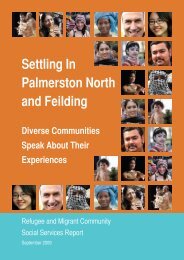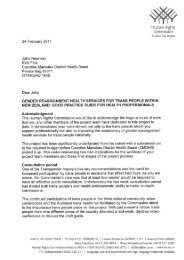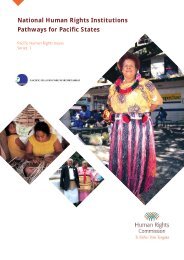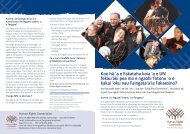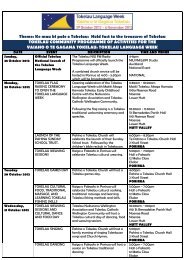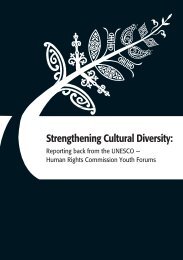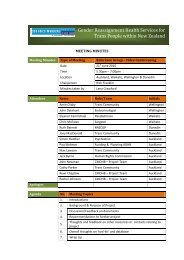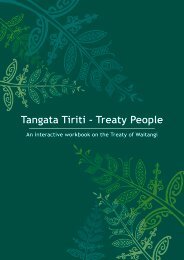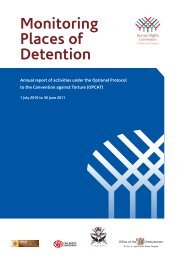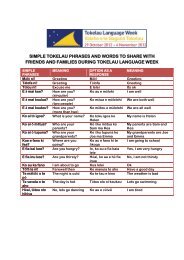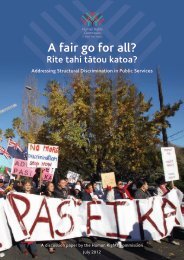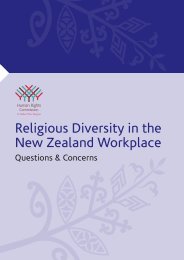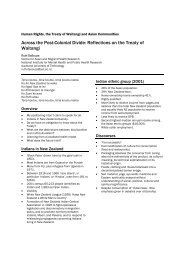Te Mana i Waitangi - Human Rights Commission
Te Mana i Waitangi - Human Rights Commission
Te Mana i Waitangi - Human Rights Commission
Create successful ePaper yourself
Turn your PDF publications into a flip-book with our unique Google optimized e-Paper software.
<strong>Te</strong> <strong>Mana</strong> i<br />
<strong>Waitangi</strong><br />
<strong>Human</strong> <strong>Rights</strong> and the<br />
Treaty of <strong>Waitangi</strong><br />
To be used in conjunction with the<br />
Powerpoint presentation<br />
<strong>Te</strong> <strong>Mana</strong> i <strong>Waitangi</strong>
Contact the <strong>Commission</strong><br />
<strong>Human</strong> <strong>Rights</strong> <strong>Commission</strong> InfoLine<br />
If you have a human rights enquiry or discrimination complaint, call:<br />
0800 496 877 (toll free)<br />
TXT 0210 236 4253<br />
Fax 09 377 3593 (attn: InfoLine)<br />
Email infoline@hrc.co.nz<br />
Language Line and New Zealand Sign Language interpreter available<br />
www.hrc.co.nz<br />
Tämaki Makaurau – Auckland<br />
Level 3, 21 Queen Street<br />
PO Box 6751, Wellesley Street, Tämaki Makaurau Auckland 1141<br />
Waea/telephone 09 309 0874<br />
Waea whakähua/fax 09 377 3593<br />
<strong>Te</strong> Whanganui ä Tara – Wellington<br />
Level 1 Vector Building, 44-52 The <strong>Te</strong>rrace<br />
PO Box 12411, Thorndon, <strong>Te</strong> Whanganui ä Tara Wellington 6144<br />
Waea/telephone 04 473 9981<br />
Waea whakähua/fax 04 471 6759<br />
Ötautahi – Christchurch<br />
Level 2 Plan B Building, 9 Baigent Way<br />
PO Box 1578, Ötautahi Christchurch 8140<br />
Waea/telephone 03 379 2015<br />
Waea whakähua/fax 03 353 0959<br />
ISBN 978-0-478-34991-7 (online)<br />
Published June 2011<br />
Auckland, Aotearoa New Zealand
Contents<br />
Ngä kaupapa<br />
Treaty of <strong>Waitangi</strong> 1840 – English text 4<br />
Treaty of <strong>Waitangi</strong> 1840 – A literal English Translation of the Mäori text 5<br />
<strong>Te</strong> <strong>Mana</strong> i <strong>Waitangi</strong> 6<br />
Introduction<br />
Glossary 7<br />
Slide 1 8<br />
A promise of two peoples<br />
Slide 2 9<br />
The Treaty belongs to all of us<br />
Slide 3 10<br />
The Treaty is the founding document of our nation<br />
Slide 4 11<br />
Preamble<br />
Slide 5 12<br />
Käwanatanga/Governance<br />
Slide 6 13<br />
Rangatiratanga/Self Determination<br />
Slide 7 14<br />
Equality, Rite Tahi and Türangawaewae<br />
Slide 8 15<br />
Wairua and Spirituality<br />
Slide 9 16<br />
International Standards<br />
Slide 10 17<br />
Current Issues<br />
Slide 11 18<br />
<strong>Te</strong> <strong>Mana</strong> i <strong>Waitangi</strong><br />
Feedback form 19
<strong>Te</strong> <strong>Mana</strong> i <strong>Waitangi</strong> | <strong>Human</strong> RigHTs and THe Treaty of <strong>Waitangi</strong><br />
4<br />
Treaty of <strong>Waitangi</strong> 1840<br />
[English <strong>Te</strong>xt]<br />
Her Majesty Victoria, Queen of the United Kingdom<br />
of Great Britain and Ireland, regarding with Her<br />
Royal Favour the Native Chiefs and Tribes of New<br />
Zealand, and anxious to protect their just <strong>Rights</strong> and<br />
Property, and to secure to them the enjoyment of<br />
Peace and Good Order, has deemed it necessary, in<br />
consequence of the great number of Her Majesty’s<br />
Subjects, who have already settled in New Zealand,<br />
and the rapid extension of Emigration both from<br />
Europe and Australia which is still in progress,<br />
to constitute and appoint a functionary properly<br />
authorized to treat with the Aborigines of New<br />
Zealand for the recognition of Her Majesty’s<br />
Sovereign authority over the whole or any part of<br />
those islands.<br />
Her Majesty, therefore, being desirous to establish<br />
a settled form of Civil Government with a view to<br />
avert the evil consequences which must result from<br />
the absence of the necessary Laws and Institutions<br />
alike to the Native population and to Her subjects,<br />
has been graciously pleased to empower and to<br />
authorize me, William Hobson, a Captain in Her<br />
Majesty’s Royal Navy, Consul, and Lieutenant<br />
Governor of such parts of New Zealand as may be,<br />
or hereafter shall be, ceded to Her Majesty, to invite<br />
the confederated and Independent Chiefs of New<br />
Zealand to concur in the following Articles and<br />
Conditions.<br />
Article The First<br />
The Chiefs of the Confederation of the United Tribes<br />
of New Zealand, and the separate and Independent<br />
Chiefs who have not become members of the<br />
Confederation, cede to Her Majesty the Queen of<br />
England, absolutely and without reservation, all<br />
the rights and powers of Sovereignty which the<br />
said Confederation or Individual Chiefs respectively<br />
exercise or possess, or may be supposed to exercise<br />
or to possess, over their respective <strong>Te</strong>rritories as the<br />
sole Sovereigns thereof.<br />
ARTICLE THE SECOND<br />
Her Majesty the Queen of England confirms and<br />
guarantees to the Chiefs and Tribes of New Zealand<br />
and to the respective families and individuals<br />
thereof, the full, exclusive, and undisturbed<br />
possession of their Lands and Estates, Forests,<br />
Fisheries and other properties which they may<br />
collectively or individually possess, so long as it<br />
is their wish and desire to retain the same in their<br />
possession, but the Chiefs of the United Tribes<br />
and the individual Chiefs yield to Her Majesty the<br />
exclusive right of Pre-emption over such lands as the<br />
proprietors and persons appointed by Her Majesty to<br />
treat with them in that behalf.<br />
ARTICLE THE THIRD<br />
In consideration thereof, Her Majesty the Queen of<br />
England extends to the Natives of New Zealand Her<br />
Royal protection and imparts to them all the <strong>Rights</strong><br />
and Privileges of British Subjects.<br />
W Hobson<br />
Lieutenant-Governor<br />
Now, therefore, We, the Chiefs of the Confederation<br />
of the United Tribes of New Zealand, being<br />
assembled in Congress at Victoria, in <strong>Waitangi</strong>, and<br />
We, the Separate and Independent Chiefs of New<br />
Zealand claiming authority over the Tribes and<br />
<strong>Te</strong>rritories which are specified after our respective<br />
names, having been made to fully understand the<br />
Provisions of the foregoing Treaty, accept and enter<br />
into the same in the full spirit and meaning thereof,<br />
in witness of which, we have attached our signatures<br />
or marks at the places and the dates respectively<br />
specified. Done at <strong>Waitangi</strong> this Sixth day of<br />
February in the year of Our Lord one thousand eight<br />
hundred and forty.<br />
Translation: The Governor says that the several<br />
faiths (beliefs) of England, of the Wesleyans, of Rome<br />
and also Maori custom shall alike be protected by<br />
him.<br />
Reference: Treaty of <strong>Waitangi</strong> Act 1975 schedule 1
<strong>Te</strong> <strong>Mana</strong> i <strong>Waitangi</strong> | <strong>Human</strong> RigHTs and THe Treaty of <strong>Waitangi</strong><br />
5<br />
Treaty of <strong>Waitangi</strong> 1840<br />
[A literal English translation of the Mäori <strong>Te</strong>xt]<br />
VICTORIA, the Queen of England, in her kind<br />
(gracious) thoughtfulness to the Rangatira and Hapu<br />
of New Zealand, and her desire to preserve to them<br />
their Rangatiratanga and their land, and that peace<br />
and quietness may be kept with them, because a<br />
great number of the people of her tribe have settled<br />
in this country, and (more) will come, has thought<br />
it right to send an officer as one who will make<br />
a statement to (negotiate with) Maori people of<br />
New Zealand. Let the Maori Rangatira accept the<br />
governorship (KAWANATANGA) of the Queen over<br />
all parts of this country and the Islands. Now, the<br />
Queen desires to arrange the governorship lest evils<br />
should come to the Maori people and the Europeans<br />
who are living here without law. Now, the Queen has<br />
been pleased to send me, William Hobson, a Captain<br />
in the Royal Navy to be Governor for all places of<br />
New Zealand which are now given up or which<br />
shall be given up to the Queen. And she says to the<br />
Rangatira of the Confederation of the Hapu of New<br />
Zealand and the other Rangatira, these are the laws<br />
spoken of.<br />
THIS IS THE FIRST<br />
The Rangatira of the Confederation and all the<br />
Rangatira who have not joined that Confederation<br />
give absolutely to the Queen of England for ever all<br />
the Governorship (KAWANATANGA) of their lands.<br />
THIS IS THE THIRD<br />
This is the arrangement for the consent to the<br />
governorship of the Queen. The Queen will protect<br />
all the Maori people of New Zealand, and give them<br />
all the same rights as those of the people of England.<br />
WILLIAM HOBSON<br />
Consul and Lieutenant-Governor<br />
Now, we the Rangatira of the Confederation of the<br />
Hapu of New Zealand, here assembled at <strong>Waitangi</strong>,<br />
and we, the Rangatira of New Zealand, see the<br />
meaning of these words and accept them, and we<br />
agree to all of them. Here we put our names and our<br />
marks.<br />
Governor Hobson’s Statement<br />
The Catholic Bishop, Pompalier and the Anglican<br />
Missionary, William Colenso recorded a discussion on<br />
what we would call religious freedom and customary<br />
law. In answer to a direct question from Pompalier,<br />
Hobson agreed to the following statement It was<br />
read to the meeting before any of the Rangatira had<br />
signed the Treaty.<br />
“The Governor says that the several faiths (beliefs) of<br />
England, of the Wesleyans, of Rome, and also Maori<br />
custom shall alike be protected by him.”<br />
Reference: Treaty of <strong>Waitangi</strong> Act 1975 schedule 1<br />
THIS IS THE SECOND<br />
The Queen of England agrees and consents (to give)<br />
to the Rangatira, hapu, and all the people of New<br />
Zealand the full rangatiratanga of their lands, their<br />
villages and all their possessions (taonga; everything<br />
that is held precious) but the Rangatira give to the<br />
Queen the purchasing of those pieces of land which<br />
the owner is willing to sell, subject to the arranging<br />
of payment which will be agreed to by them and the<br />
purchaser who will be appointed by the Queen for<br />
the purpose of buying for her.
<strong>Te</strong> <strong>Mana</strong> i <strong>Waitangi</strong> | <strong>Human</strong> RigHTs and THe Treaty of <strong>Waitangi</strong><br />
6<br />
<strong>Te</strong> <strong>Mana</strong> i <strong>Waitangi</strong><br />
<strong>Human</strong> <strong>Rights</strong> and the Treaty of <strong>Waitangi</strong><br />
Tüia te rangi e tü nei. Tüia te papa e takoto nei. Tüia<br />
te here tangata. Ka rongo te pö, ka rongo te ao. Tihei<br />
Mauriora.<br />
Tüia rätou kua wehe atu ki te pö uriuri, te pö<br />
tangotango, te maimai aroha. Haere ngä mate, haere<br />
atu rä.<br />
I whakapümautia e <strong>Te</strong> Tiriti o <strong>Waitangi</strong> he<br />
kohikohinga körero o ngä tika me ngä kawenga me<br />
he hononga i waenga i te Karauna me ngä Rangatira,<br />
e toitü ana i tënei rä. I hangaia mai he anga mana<br />
whakahaere (käwanatanga), whakakoia te mana<br />
motuhake ä te Tangata Whenua (rangatiratanga) ä<br />
ka whakaoati he iwi whenua me ngä tika örite mä te<br />
katoa (rite tahi).<br />
Kua whakaahuatia te Tiriti hei:<br />
“He kupu oati o ngä hunga e rua kia manaaki tëtahi<br />
ki tëtahi”<br />
Kai roto ngä tika tangata katoa me ngä tika taketake<br />
i ngä korahi tika tangata o <strong>Te</strong> Tiriti o <strong>Waitangi</strong><br />
<strong>Te</strong> <strong>Mana</strong> i <strong>Waitangi</strong> has been developed by the<br />
<strong>Human</strong> <strong>Rights</strong> <strong>Commission</strong> to help identify the<br />
human rights dimensions of the Treaty of <strong>Waitangi</strong>. It<br />
works towards a greater understanding of the human<br />
rights aspects of the Treaty and the implications in<br />
our lives today.<br />
One of the <strong>Commission</strong>’s functions under the<br />
<strong>Human</strong> <strong>Rights</strong> Act is to “promote by research,<br />
education, and discussion a better understanding<br />
of the human rights dimensions of the Treaty of<br />
<strong>Waitangi</strong> and their relationship with domestic and<br />
international human rights law” (section 5(2) (d)).<br />
This resource was developed to help fulfill this<br />
obligation. Its development has encompassed more<br />
than 400 workshops and education sessions before<br />
being tested on about thirty groups. Feedback has<br />
been positive with participants advising us that it<br />
encouraged them to:<br />
• read and discuss the Treaty<br />
• be better informed about human rights and the<br />
Treaty<br />
• feel competent to discuss the Treaty, with<br />
some authority, amongst friends, whänau and<br />
colleagues<br />
• see the relevance of the Treaty to their whänau,<br />
community and workplace.<br />
The Treaty is in three parts; the preamble, the articles<br />
and the concluding statement of agreement. This<br />
resource helps to articulate, advise and empower<br />
people about the human rights dimensions of the<br />
Treaty by exploring its different aspects. It promotes<br />
the Treaty as:<br />
• a promise of two peoples to take the best possible<br />
care of each other<br />
• the founding document of our nation<br />
• belonging to all citizens and residents of Aotearoa<br />
New Zealand, including Tangata Whenua, multi<br />
generational New Zealanders and recent migrants.<br />
<strong>Te</strong> <strong>Mana</strong> i <strong>Waitangi</strong> also identifies links to<br />
international human rights instruments and<br />
standards and draws attention to some areas that<br />
are unresolved, most of which need legal or political<br />
resolution. It can be used in individual or group<br />
situations. If you’d like help with facilitating your<br />
sessions using this resource, then please contact<br />
us. This booklet has been designed to be used<br />
in conjunction with a Powerpoint presentation<br />
available at www.hrc.co.nz/treaty.<br />
With a greater understanding of the Treaty and its<br />
very real implications for Aotearoa today, the Treaty<br />
can realise its promise of two peoples to take the<br />
best possible care of each other.
<strong>Te</strong> <strong>Mana</strong> i <strong>Waitangi</strong> | <strong>Human</strong> RigHTs and THe Treaty of <strong>Waitangi</strong><br />
7<br />
Glossary<br />
Aotearoa<br />
Hapü<br />
Iwi<br />
Kawa<br />
Käwanatanga<br />
<strong>Mana</strong> Atua<br />
Päkehä<br />
Rangatira<br />
Rangatiratanga<br />
Tangata Whenua<br />
Tauiwi<br />
Tikanga<br />
Treaty<br />
Türangawaewae<br />
Whakapapa<br />
Whänau<br />
Constitution<br />
Self determination<br />
New Zealand<br />
Traditional family groupings based on whakapapa. Political entity<br />
Political entity based on hapü groupings and whakapapa<br />
The values, rules, and institutions through which people govern themselves<br />
Governance<br />
Spiritual authority<br />
New Zealand settlers and their descendants<br />
Leader of whänau, hapü, marae or iwi<br />
Self determination<br />
People of the land, original indigenous peoples<br />
Landed or landing people. People who arrived after Tangata Whenua<br />
Laws, rules that determine and guide behaviour<br />
An international agreement between sovereign peoples<br />
Authority to belong<br />
Genealogy<br />
Multi-generational families<br />
The values, rules, and institutions through which people govern themselves<br />
The right all peoples have to determine their own economic, social and cultural<br />
development
<strong>Te</strong> <strong>Mana</strong> i <strong>Waitangi</strong> | <strong>Human</strong> RigHTs and THe Treaty of <strong>Waitangi</strong><br />
8<br />
Slide 1<br />
“A promise of<br />
two peoples to<br />
take the best<br />
possible care of<br />
each other.”<br />
<strong>Te</strong> <strong>Mana</strong> i <strong>Waitangi</strong><br />
<strong>Human</strong> <strong>Rights</strong> and the Treaty of <strong>Waitangi</strong><br />
“A promise of two peoples to take the best<br />
possible care of each other.” – Bishop Bennett<br />
<strong>Te</strong> <strong>Mana</strong> i <strong>Waitangi</strong> (the authority established at<br />
<strong>Waitangi</strong>) can be used as a tool to explore the Treaty<br />
of <strong>Waitangi</strong> in such a way that workshop participants<br />
will come to a better understanding of the Treaty<br />
and what it means to New Zealanders today. It aims<br />
to capture what was in the hearts and minds of<br />
our tïpuna/ancestors at the signing of the Treaty in<br />
1840 and looks at its relevance here and now. This<br />
resource promotes the Treaty as:<br />
• a promise of two peoples to take the best possible<br />
care of each other<br />
• belonging to all of us<br />
• the founding document of Aotearoa,<br />
New Zealand.<br />
<strong>Te</strong> <strong>Mana</strong> i <strong>Waitangi</strong> provides a framework to consider<br />
how the Treaty’s promise can be realised.<br />
The two peoples are:<br />
• Tangata Whenua (people of the land) represented<br />
by Rangatira from whänau, hapü and iwi of<br />
Aotearoa<br />
• Tauiwi (landed or landing people) represented by<br />
the Crown.<br />
Dr Merimeri Penfold<br />
All people have human rights and responsibilities.<br />
This Treaty resource aims to explore and explain the<br />
rights and responsibilities of the parties to the Treaty.<br />
It focuses on where the two texts agree.<br />
The constitutional basis of the Treaty remains<br />
unresolved between the Crown and Rangatira.<br />
Note: Bishop Manuhuia Bennett’s quote is from the<br />
<strong>Te</strong> Roroa Report to the <strong>Waitangi</strong> Tribunal, 1992.<br />
Reflections<br />
• Consider if you are Tangata Whenua, Tauiwi, or<br />
both. Describe your situation at the time of signing<br />
the Treaty. What are the issues confronting you?<br />
Why would you want/not want to sign the Treaty?<br />
• What does the promise involve?<br />
• What were the motivations for the promise?<br />
What did Rangatira want for their whanäu? What<br />
did the Crown want for their whänau?<br />
Slide 1: King, Marcus, 1891-1983 (The signing of the Treaty of <strong>Waitangi</strong>,<br />
February 6, 1840) 1938. [Ref. No. G-821-2] Alexander Turnbull Library.<br />
Archives New Zealand/<strong>Te</strong> Rua Mahara o te Käwanatanga. Wellington<br />
Office. [Ref. IA9/9]
<strong>Te</strong> <strong>Mana</strong> i <strong>Waitangi</strong> | <strong>Human</strong> RigHTs and THe Treaty of <strong>Waitangi</strong><br />
9<br />
Slide 2<br />
The Treaty<br />
belongs to all<br />
of us<br />
Tūrangawaewae<br />
“A standing place from<br />
where you gain the<br />
authority to belong.”<br />
(Hiwi and Pat Tauroa)<br />
The Treaty belongs to all of us.<br />
The Treaty is often thought to be a Mäori only treaty.<br />
In fact, the Treaty protects all New Zealanders,<br />
giving all New Zealand citizens a türangawaewae.<br />
Türangawaewae is our authority and right to belong.<br />
It also involves both rights and responsibilities.<br />
UMR survey results<br />
A <strong>Human</strong> <strong>Rights</strong> <strong>Commission</strong> survey conducted in<br />
2010 showed that 51 per cent of New Zealanders<br />
believe the Treaty belongs to all of us.<br />
Tü = stand,<br />
Türanga = standing place,<br />
Waewae = feet<br />
Reflections<br />
• Where is your türangawaewae?<br />
• What are your rights and responsibilities to your<br />
türangawaewae?<br />
• What icons identify this place?<br />
• Why have you identified this place as your<br />
türangawaewae?<br />
“But then we must not forget that the Treaty is not<br />
just a bill of rights for Mäori. It is a bill of rights for<br />
Päkehä, too. It is the Treaty that gives Päkehä the<br />
right to be here. Without the Treaty, there would be<br />
no lawful authority for the Päkehä presence in this<br />
part of the South Pacific.”<br />
Chief Judge Eddie Durie<br />
Türangawaewae: It is a standing place from where<br />
one gains the authority to belong.<br />
Hiwi and Pat Tauroa,<br />
<strong>Te</strong> Marae: A guide to Customs and Protocol,<br />
Raupo Publishing (NZ) Ltd, 2004
<strong>Te</strong> <strong>Mana</strong> i <strong>Waitangi</strong> | <strong>Human</strong> RigHTs and THe Treaty of <strong>Waitangi</strong><br />
10<br />
Slide 3<br />
The Treaty is<br />
the founding<br />
document of<br />
our nation<br />
The Treaty of <strong>Waitangi</strong> 1840<br />
The Treaty of <strong>Waitangi</strong> created<br />
tūrangawaewae for all<br />
New Zealanders.<br />
It also affirms the tūrangawaewae<br />
status that tangata whenua already<br />
possessed.<br />
The Treaty is the<br />
founding document of<br />
our nation.<br />
Tangata Whenua have always had türangawaewae<br />
status in Aotearoa New Zealand. The Treaty<br />
established this status for all other New Zealanders<br />
by building a foundation for Mäori and all New<br />
Zealanders to live together.<br />
UMR survey results<br />
A <strong>Human</strong> <strong>Rights</strong> <strong>Commission</strong> survey conducted in<br />
2010 showed that 60 per cent of New Zealanders<br />
believe the Treaty is the founding document of our<br />
nation. However, only a third of New Zealanders say<br />
they have reasonable knowledge of the Treaty.<br />
Reflections<br />
• Why is so little known about the Treaty?<br />
• As the founding document of our nation, how<br />
does the Treaty affect our lives? (E.g. our whanau/<br />
community/ workplace)<br />
• How does the Treaty influence our constitutional<br />
arrangements?
<strong>Te</strong> <strong>Mana</strong> i <strong>Waitangi</strong> | <strong>Human</strong> RigHTs and THe Treaty of <strong>Waitangi</strong><br />
11<br />
Slide 4<br />
Preamble<br />
The Preamble tells us<br />
Who<br />
• Queen Victoria<br />
• William Hobson<br />
• Native Chiefs<br />
• Confederated and<br />
Independent Chiefs<br />
• Rangatira<br />
• Hapū<br />
• Her Majesty’s<br />
Subjects<br />
• Aborigines of<br />
New Zealand<br />
• Native population<br />
• Her subjects/people<br />
• Māori<br />
• Europeans<br />
• Australians<br />
Why<br />
• Recognition of Her Majesty’s<br />
Sovereign authority<br />
• Establish a settled form of<br />
Civil government<br />
• Preserve rangatiratanga<br />
and their land<br />
• Peace and quietness<br />
• Her tribe have settled in this<br />
country and (more) will come<br />
• Rapid extension of immigration<br />
• Protect just rights and property<br />
• Avert the evil consequences<br />
which must result from the<br />
absence of the necessary<br />
Law and Institutions<br />
How<br />
• Treat with the<br />
Aborigines of NZ<br />
• Concur<br />
• Make a statement<br />
• Negotiate with<br />
• Accept and agree<br />
• Constitute and<br />
appoint a<br />
functionary<br />
*All text is taken from the Treaty<br />
This next section looks at what the Treaty says. There<br />
are three parts to the Treaty:<br />
• the preamble provides a context and tells us who<br />
(it was for), why and how<br />
• the articles tell us what was agreed<br />
• the concluding statement authorises the Treaty.<br />
When working through this resource, read the Treaty<br />
texts on pages 4 and 5.<br />
The preamble provides a context for the Treaty. It<br />
tells us:<br />
• who it was for (parties involved)<br />
• why they wanted it<br />
• how they were going to go about drawing up a<br />
Treaty.<br />
The text on this slide is copied from the Treaty text.<br />
The Treaty of <strong>Waitangi</strong> and Immigration in 1840<br />
The Treaty is recognised as the first immigration<br />
agreement between Mäori and Päkehä (European<br />
settlers). Originally, the Treaty allowed settlers<br />
to emigrate peacefully to New Zealand under<br />
the British flag. The Treaty was an important<br />
document. Firstly, it controlled the thousands<br />
of future emigrants to Aotearoa New Zealand,<br />
and secondly, it protected the rights of Mäori<br />
people. The benefits to both parties were clear<br />
– settlement rights for Päkehä and the natural<br />
rights of Tangata Whenua would be respected and<br />
affirmed.<br />
01 The Treaty of <strong>Waitangi</strong>, An introduction to the<br />
Treaty of <strong>Waitangi</strong> for Migrants,<br />
Immigration New Zealand<br />
Reflections<br />
• Who are the parties to the Treaty identified in<br />
the preamble?<br />
• Who were they represented by?<br />
• What benefits were being sought through the<br />
Treaty? Who would benefit?
<strong>Te</strong> <strong>Mana</strong> i <strong>Waitangi</strong> | <strong>Human</strong> RigHTs and THe Treaty of <strong>Waitangi</strong><br />
12<br />
Slide 5<br />
Käwanatanga/<br />
Governance<br />
Purpose<br />
Who<br />
What<br />
Article One – Kāwanatanga<br />
Governance/Kāwanatanga<br />
Crown/Government<br />
Rangatira gave and the Crown gained an authority<br />
to govern<br />
<strong>Rights</strong> – for example:<br />
Responsibilities – for example:<br />
To make laws<br />
Gather taxes<br />
Set up institutions<br />
Make agreements with other peoples<br />
Represent the State<br />
Create property rights<br />
Ensure laws are fair<br />
Observe principles of natural justice<br />
Protect our constitution<br />
Provide services<br />
Ensure democracy<br />
Act in good faith<br />
Promote and protect human rights<br />
Respect the Treaty<br />
The articles of the Treaty tell us what was agreed.<br />
Article One established the Crown as a party to the<br />
Treaty with Rangatira giving the Crown an authority<br />
to govern. This authority came with rights and<br />
responsibilities.<br />
The English text claims sovereignty as the extent of<br />
governance and the Reo text claims Käwanatanga<br />
(governance). This difference remains unresolved<br />
between Rangatira and the Crown.<br />
The rights and responsibilities associated with<br />
Käwanatanga are protected by law and regulation.<br />
Reflections<br />
• There are differences in interpretations of the two<br />
texts. Where do the texts agree?<br />
• What was agreed? What was gained/given/<br />
affirmed?<br />
• What are the rights and responsibilities associated<br />
with this agreement?<br />
• What does that mean in practice especially the<br />
promise of two peoples to take the best possible<br />
care of each other?
<strong>Te</strong> <strong>Mana</strong> i <strong>Waitangi</strong> | <strong>Human</strong> RigHTs and THe Treaty of <strong>Waitangi</strong><br />
13<br />
Slide 6<br />
Rangatiratanga/<br />
Self<br />
determination<br />
Purpose<br />
Who<br />
What - 1<br />
Article Two: Rangatiratanga<br />
Self Determination, Rangatiratanga<br />
Rangatira<br />
The Crown promised to protect and Rangatira affirmed their<br />
authority over their taonga<br />
What - 2<br />
<strong>Rights</strong> – for example:<br />
Responsibilities – for<br />
example:<br />
Rangatira gave and the Crown gained the pre-emptive right to<br />
purchase properties Rangatira wished to sell<br />
To protect and develop their laws (tikanga, kawa)<br />
Approve the use of their resources (rauemi)<br />
Protect and develop their institutions (whānau, hapū, marae)<br />
Make agreements with other peoples (whanaungatanga)<br />
Self determination (rangatiratanga)<br />
Maintain their distinct identity (whakapapa)<br />
Protect and develop beliefs (wairuatanga)<br />
Own property (hoko whenua)<br />
Respect the rights of others (manaakitanga)<br />
Exercise fair judgement (kawa)<br />
Sustainable protection of land, people and values (kaitiakitanga)<br />
Act in good faith (whakapono)<br />
Promote and protect human rights (mana tangata)<br />
Protect their world views (mātauranga)<br />
Respect the Treaty<br />
Article Two established Rangatira as a party to the<br />
Treaty. This article has two parts. Rangatira affirmed<br />
their authority over their taonga and the Crown<br />
guaranteed to actively ensure the protection of their<br />
rangatiratanga (self determination).<br />
In addition, Rangatira gave the Crown the preemptive<br />
right to purchase properties Rangatira<br />
wished to sell. The relationship between Tangata<br />
Whenua and their land (we belong to the land) was<br />
supplemented by “property rights” (and the land<br />
belongs to us).<br />
The rights associated with rangatiratanga are<br />
indigenous rights. They are protected by tikanga and<br />
kawa, and in some cases, by law and regulation.<br />
The United Nations Declaration on the <strong>Rights</strong> of<br />
Indigenous Peoples explains the standards to be<br />
pursued for indigenous rights to be achieved.<br />
There is a difference in the translations between<br />
the two texts. The English text claims “possession”<br />
will remain with Rangatira and the Reo text claims<br />
“rangatiratanga”(self determination). The difference<br />
remains unresolved between the Crown and<br />
Rangatira.<br />
Reflections<br />
• There are differences in interpretation. Where do<br />
the texts agree?<br />
• What was agreed? What was gained/given/<br />
affirmed?<br />
• What are the rights and responsibilities associated<br />
with this?<br />
• What does this mean in practice especially the<br />
promise of two peoples to take the best possible<br />
care of each other?<br />
The Treaty settlement process provides evidence that<br />
the rights of Tangata Whenua have been breached<br />
by the Crown.
<strong>Te</strong> <strong>Mana</strong> i <strong>Waitangi</strong> | <strong>Human</strong> RigHTs and THe Treaty of <strong>Waitangi</strong><br />
14<br />
Slide 7<br />
Equality,<br />
Rite Tahi and<br />
Türangawaewae<br />
Purpose<br />
Who<br />
What<br />
Article Three: Rite Tahi<br />
Rite Tahi, Equality, Tūrangawaewae<br />
Citizens and Residents<br />
The Crown gave Tangata Whenua the same rights as<br />
British subjects, who gained the authority to belong<br />
<strong>Rights</strong> – for example:<br />
Responsibilities – for<br />
example:<br />
Equality before the law<br />
Fair process<br />
Free speech, thought and beliefs<br />
Good health and education<br />
Culture<br />
Vote<br />
To belong (turangawaewae)<br />
Own land or property<br />
Obey the law<br />
Participate in community<br />
Pay taxes<br />
Vote<br />
Promote and protect human rights<br />
Protect and assist youth<br />
Look after people who are vulnerable<br />
Respect the Treaty<br />
Article Three gave Tangata Whenua the same<br />
citizenship rights as British subjects (tauiwi), who had<br />
gained an authority to belong through the Treaty.<br />
The notion of citizenship has expanded beyond<br />
these two groups and now includes all citizens and<br />
residents.<br />
Citizenship has rights and responsibilities and the<br />
examples on this slide reflect a sample of rights and<br />
responsibilities identified by participants of previous<br />
<strong>Te</strong> <strong>Mana</strong> i <strong>Waitangi</strong> workshops.<br />
Reflections<br />
• Where do the texts agree?<br />
• What was agreed? What was gained/given/<br />
affirmed?<br />
• What are the rights and responsibilities associated<br />
with this?<br />
• What does this mean in practice especially the<br />
promise of two peoples to take the best possible<br />
care of each other?<br />
Newly arrived tauiwi (e.g. from the Pacific, Europe,<br />
Asia and Africa) often ask how the Treaty relates to<br />
them. The Treaty entitles all citizens and residents<br />
the full protection of the human rights dimensions<br />
of the Treaty of <strong>Waitangi</strong>. These rights are generally<br />
protected by law and regulation, and in some cases,<br />
by kawa and tikanga.<br />
Many Pacific peoples have whakapapa links to<br />
Tangata Whenua. These links have still to be fully<br />
realised in the Treaty today.
<strong>Te</strong> <strong>Mana</strong> i <strong>Waitangi</strong> | <strong>Human</strong> RigHTs and THe Treaty of <strong>Waitangi</strong><br />
15<br />
Slide 8<br />
Wairua and<br />
Spirituality<br />
Wairuatanga<br />
This statement was read to the meeting<br />
before any of the Rangatira signed<br />
The Treaty:<br />
“The Governor says that the several<br />
faiths (beliefs) of England, of the<br />
Wesleyans, of Rome and also Māori<br />
custom shall alike be protected by him.”<br />
Catholic Bishop Pompallier and Anglican missionary<br />
William Colenso recorded a discussion on what we<br />
would now call religious freedom. In answer to a<br />
direct question from Bishop Pompallier, Lieutenant<br />
Governor Hobson agreed to the statement on this<br />
slide. This was a verbal agreement.<br />
The religions listed were the only organised religions<br />
present in the country at the time of the signing<br />
of the Treaty. However, this is seen as the right to<br />
practice religion and customs along with the right of<br />
freedom to choose a religion. This is often called the<br />
4th Article.<br />
Reflections<br />
• What are the rights and responsibilities associated<br />
with this ‘article’?<br />
• What does this mean for secular societies?<br />
• What does this mean in practice especially the<br />
promise of two peoples to take the best possible<br />
care of each other?<br />
“It is unlikely Tangata Whenua would have signed if<br />
this was not agreed. The rest of the Treaty is about<br />
land and people. This is the <strong>Mana</strong> Atua (spirituality)<br />
dimension that makes sense to Tangata Whenua<br />
values and practices.”<br />
Dr. Merimeri Penfold
<strong>Te</strong> <strong>Mana</strong> i <strong>Waitangi</strong> | <strong>Human</strong> RigHTs and THe Treaty of <strong>Waitangi</strong><br />
16<br />
Slide 9<br />
International<br />
Standards<br />
International Standards<br />
Declarations and Treaties help to:<br />
• Establish standards<br />
• Affirm the rights and responsibilities of the parties<br />
Examples:<br />
• Universal Declaration of <strong>Human</strong> <strong>Rights</strong> (UDHR)<br />
• Declaration on the <strong>Rights</strong> of Indigenous Peoples (UNDRIP)<br />
• International Covenant on Civil and Political <strong>Rights</strong> (ICCPR)<br />
• International Covenant on Economic, Social & Cultural <strong>Rights</strong><br />
(ICESCR)<br />
United Nations human rights instruments (e.g.<br />
charters, convenants, conventions, declarations,<br />
protocols, treaties) establish international human<br />
rights standards.<br />
The UN Universal Declaration of <strong>Human</strong> <strong>Rights</strong><br />
(1948) sets out a universal set of human rights<br />
standards. Signed in 1948, it was the international<br />
community’s commitment to human rights for<br />
everyone, everywhere. Since then, the UN has<br />
developed treaties to which member countries sign<br />
up and report against periodically. Some of the<br />
better known treaties are:<br />
• International Covenant on Economic, Social and<br />
Cultural <strong>Rights</strong> (ICESCR)<br />
• International Covenant on Civil and Political <strong>Rights</strong><br />
(ICCPR)<br />
In 2007, the UN adopted the Declaration on the<br />
<strong>Rights</strong> of Indigenous Peoples which New Zealand<br />
endorsed in 2010. This declaration’s aim is to be<br />
achieved in a spirit of partnership and mutual<br />
respect.<br />
Reflections<br />
• What are the rights and responsibilities associated<br />
with international standards?<br />
• What does this mean in practice especially the<br />
promise of two peoples to take the best possible<br />
care of each other?<br />
• How well does NZ perform to these standards?<br />
• How do international standards relate to the<br />
Treaty of <strong>Waitangi</strong>?<br />
• International Convention on the Elimination of all<br />
Forms of Discrimination against Women (CEDAW)<br />
• International Convention on the Elimination of<br />
Racial Discrimination (CERD)<br />
• Convention on the <strong>Rights</strong> of the Child (UNCRoC)<br />
• Convention on the <strong>Rights</strong> of Persons with<br />
Disabilities (CRPD).
<strong>Te</strong> <strong>Mana</strong> i <strong>Waitangi</strong> | <strong>Human</strong> RigHTs and THe Treaty of <strong>Waitangi</strong><br />
17<br />
Slide 10<br />
Current Issues<br />
Current Issues<br />
• Sovereignty vs Kāwanatanga<br />
• Rangatiratanga vs possession<br />
• Indigenous <strong>Rights</strong><br />
• Settlement of grievances<br />
• Relevance today: Constitution<br />
• Forums for engagement<br />
What other Treaty issues are<br />
current?<br />
There are a number of issues that are unresolved and<br />
not clearly understood by many New Zealanders.<br />
Most need political or legal resolution. The ones in<br />
this slide are recurring themes with participants.<br />
Following are some statements that highlight the<br />
issues.<br />
Mäori/English versions<br />
There are differences in the text that have<br />
caused conflict. The international law of “contra<br />
proferentem” means that where there are two<br />
versions of an agreement or Treaty the preference<br />
goes against the drafter of the text. In the case of the<br />
Treaty of <strong>Waitangi</strong>, preference would go to the te reo<br />
Mäori text as the Crown drafted the Treaty. In New<br />
Zealand, domestic legislation requires the <strong>Waitangi</strong><br />
Tribunal to give equal weight to both texts – as both<br />
carry signatures.<br />
“Today we are strong enough and honest enough to<br />
learn the lesson of the last 150 years, and to admit<br />
that the Treaty has been imperfectly observed. I look<br />
upon it as a legacy of a promise.”<br />
Queen Elizabeth II<br />
(Treaty of <strong>Waitangi</strong> celebrations,1990)<br />
Settlement of grievances:<br />
“Very few New Zealanders know that Iwi<br />
settlements to date are settled at 1-2 per cent of<br />
the value of the land and other assets that were<br />
confiscated or illegally purchased. Iwi systematically<br />
contribute 98-99 per cent of their redress<br />
entitlements back to the nation.”<br />
Bill Hamilton, Ngä Rauru Negotiator<br />
Constitution:<br />
“A constitution is simply the values, rules,<br />
and institutions through which people govern<br />
themselves. Every country develops its own<br />
constitution just as it develops its own law to<br />
reflect its own unique view of the world and then<br />
implements it through a concept and site of power<br />
that are also unique to it.”<br />
Moana Jackson, Constitutional Expert<br />
Reflections<br />
• How significant are these issues regarding “the<br />
promise of two peoples to take the best possible<br />
care of each other”?<br />
• What other Treaty issues are current?
<strong>Te</strong> <strong>Mana</strong> i <strong>Waitangi</strong> | <strong>Human</strong> RigHTs and THe Treaty of <strong>Waitangi</strong><br />
18<br />
Slide 11<br />
<strong>Te</strong> <strong>Mana</strong> i <strong>Waitangi</strong><br />
The Treaty of <strong>Waitangi</strong> established a set of rights and obligations and a<br />
relationship between the Crown and Rangatira which remains in place<br />
today. It created a governance framework for the nation (kāwanatanga),<br />
affirmed the existing rights of Tangata Whenua (rangatiratanga) and<br />
guaranteed shared citizenship and equal rights for all (rite tahi).<br />
The Treaty has been described as:<br />
“The promise of two peoples to take the<br />
best possible care of each other.”<br />
The human rights dimensions of the Treaty of <strong>Waitangi</strong> include<br />
both universal human rights and indigenous rights.<br />
<strong>Human</strong> <strong>Rights</strong> <strong>Commission</strong>, Statement of Intent 2009-2010<br />
One of the <strong>Commission</strong>’s functions under the <strong>Human</strong><br />
<strong>Rights</strong> Act is to “promote by research, education,<br />
and discussion a better understanding of the human<br />
rights dimensions of the Treaty of <strong>Waitangi</strong> and their<br />
relationship with domestic and international human<br />
rights law” (section 5(2)(d), <strong>Human</strong> <strong>Rights</strong> Act 1993).<br />
This resource helps us to articulate, give advice and<br />
empower people about the human rights dimensions<br />
of the Treaty.<br />
For help with facilitating this discussion contact us<br />
on treaty@hrc.co.nz.<br />
Please feel free to provide feedback on this resource<br />
by completing the form on page 19.<br />
This slide includes the <strong>Commission</strong>’s statement about<br />
the Treaty.<br />
Reflections<br />
• How do you think the promise has been kept?<br />
• How can we keep the promise in our own lives/<br />
workplace/school/etc?<br />
• How do you feel the Treaty applies to you/your<br />
whänau/ workplace/community?
Feedback form<br />
Did this resource help to you to:<br />
Become better informed about human rights and the Treaty?<br />
Yes<br />
No<br />
Discuss human rights and the Treaty, with some authority, amongst friends, whänau and colleagues?<br />
Yes<br />
No<br />
See the relevance of the Treaty to your whanau, community and workplace<br />
Yes<br />
No<br />
Further comments:<br />
What are the best features of the resource?<br />
What will improve the resource?<br />
Do you wish to be part of the <strong>Commission</strong>’s Treaty network? If so, please provide your details below.



